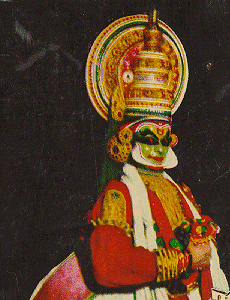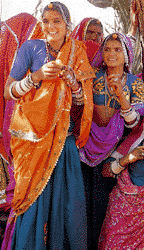Few countries in the world have such an ancient and diverse culture as India's. Stretching back in an unbroken sweep over 5000 years, India's culture has been enriched by successive waves of migration which were absorbed into the Indian way of life
Come and discover a little more of India's culture.....

History
The Indus Valley Civilisation
- The earliest human activity in the Indian sub-continent can be traced back to the Early, Middle and Late Stone Ages (400,000-200,000 BC).
- The earliest known civilisation in India, the starting point in its history, dates back to about 3000 BC. Discovered in the 1920s, it was thought to have been confined to the valley of the river Indus, hence the name given to it was Indus Valley civilisation.
- This civilisation was a highly developed urban one and two of its towns, Mohenjodaro and Harappa, represent the high watermark of the settlements.
The Muslim Invasions
- An event of immense and lasting impact in Indian history was the advent of the Muslims in the north-west, lured by tales of the fertile plains of the Punjab and the fabulous wealth of Hindu temples.
- It was only in 1192 that Muslim power arrived in India on a permanent basis.
- The languages of the Muslim invaders were modified by contact with local languages, to Urdu(Arabic script) and the more colloquial Hindustani(Devnagri script) both of which are major Indian languages today.
- The most important Islamic empire was that of the Mughals, a Central Asian dynasty founded by Babur early in the sixteenth century.
- Akbar the Great(1562-1605) was the grandson of Babur.
- Mughal culture reached its zenith during the reign of his grandson Shahjahan, a great builder and patron of the arts. Shahjehan moved his capital to Delhi and built the incomparable Taj Mahal at Agra.
Coming of the Europeans
- The great seafarers of north-west Europe, the British, French, Dutch and Portuguese, arrived early in the 17th century and established trading outposts along the coasts.
- The ultimate victors were the British, who in the first half of the 19th century, extended their hold over many Indian territories. A large part of the subcontinent was brought under The East India Company's direct administration; in some parts local rulers were retained as subsidiaries of the Company, militarily and administratively completely at its mercy and yielding to it an overwhelming portion of the revenues.
The Struggle for Independence
- By 1857, "the British empire in India had become the British empire of India." A century of accumulated grievances erupted in the Indian mutiny of sepoys in the British army, in 1857. The uprising, however, was eventually brutally supressed.
- The Indian National Congress was formed in 1885.
- But the full mobilisation of the masses into an invincible force only occured with the apperance of one of the most remarkable and charismatic leaders of the twentieth century, perhaps in history M.K. Gandhi.
- During the freedom struggle, Gandhi had developed the novel technique of non-violent agitation which he called Satyagraha.
- Under his leadership, the Congress launched the Non Cooperation Movement of 1920 -1922 and the Civil Disobedience Movement in 1930.
- India achieved independence on August 15,1947.
India chose to remain within the British Commonwealth of Nations. It also adopted the British system of Parliamentary Democracy, and retained the judicial, administrative, defence and educational structures and institutions set up by the British. India is today the largest and most populous democracy on earth.

Dance
India is a vast country...each state is different on her own, beautiful in her own unique way... There are different kinds of dance forms that have originated in different parts of India..there are folk dances, and the Classical forms of dances.

| One of the most enduring symbols of India is the figure of Shiv Nataraj or the dancing Shiva. Shiva's cosmic dance is believed to encompass creation, preservation, and destruction and this idea has been embedded in Hindu thought and ritual since the dawn of civilisation.
|
Classical Dance Forms of India
India offers a number of classical dance forms, each of which can be traced to different parts of the country. The most popular classical styles seen on the Indian stage are Bharatanatyam of Tamil Nadu, Yakshagana of Andhra Pradesh, Kathakali of Kerala, Kathak of Uttar Pradesh, and Manipuri of Manipur.

| Bharata Natyam is one of the oldest of the four major dance forms of India indigenous to Tamilnad (Southern India). The emphasis is on hand formations and facial expressions along with fast foot work to the accompaniments of percussion instruments.
|

| Kathak originated in the state of Uttar Pradesh (Northen India) and the influence of the Mughal tradition is evident in this dance form, and it has a distinct Hindu-Muslim texture.
The accent is more on footwork. The dances are performed straight-legged and the ankle bells worn by the dancers adeptly controlled. The costumes and themes of these dances are often similar to those in Mughal miniature paintings.
|

| Kathakali is the most refined, the most scientific and elaborately defined dance form of Kerala (Southern India).
As it is obtained today it is not only complete control of practically every fibre of the artistes body, but also intense senstivity of emotion. The actor does not speak, but expresses himself through highly complicated and scientifically ordained mudras and steps, closely following the text being sung from the background of the stage.
|

| Manipuri dances come from the Manipur (North-East India) . This form is essentially a folk dance and the body and arms are used extensively to communicate moods and emotions.
The dancers are primarily women who wear hooped skirts and conical caps which are extremely picturesque. Balance and a restraint of power are the predominant features of this style.
|
Clothing
To the foreign traveller, one of the powerful attractions in India is the colourful and diversified attire of its people. The silk saris, brightly mirrored cholis, colorful lehangas and the traditional salwar-kameez have fascinated many a traveler over the centuries.
Sari is the national dress of Indian women. A sari is a rectangular piece of cloth which is five to six yards in length. The style, color and texture of this cloth varies and it might be made from cotton, silk or one of the several man-made materials. This garment can fit any size and its manner of wearing as well as its color and texture are indicative of the status, age, occupation, region and religion of a woman. The tightly fitted, short blouse worn under a sari is a choli.
 Apart from the choli, women in Rajasthan wear a form of pleated skirt known as the lehanga. This skirt is secured at the waist and leaves the back and midriff bare. The heads are however covered by a length of fine cotton known as orhni or dupatta. Apart from the choli, women in Rajasthan wear a form of pleated skirt known as the lehanga. This skirt is secured at the waist and leaves the back and midriff bare. The heads are however covered by a length of fine cotton known as orhni or dupatta.
Another popular attire of women in India is the salwar-kameez . Salwars are pyjama-like trousers drawn tightly in at the waist and the ankles. Over the salwars, women wear a long and loose tunic known as a kameez.
Though the majority of Indian women wear traditional costumes, the men in India can be found in more conventional western clothing. Shirts and trousers are worn by men from all regions in India. However, men in villages are still more comfortable in traditional attire like kurtas, lungis, dhotis and pyjamas.
Religion
In India, religion is a way of life. For the majority of Indians, religion permeates every aspect of life, from common-place daily chores to education and politics.
Secular India is home to Hinduism, Islam, Christianity, Buddhism, Jainism, Sikhism, Zoroastrianism and other innumerable religious traditions. Besides Hindus, Muslims are the most prominent religious group and are an integral part of Indian society.
Hinduism Hinduism is the dominant faith, practised by over 80% of the population. Hinduism is perhaps the only religious tradition that is so diversified in its theoretical premises and practical expressions as to be called a "museum of religions". The Rig Veda, Upanishads and the Bhagwad Gita can all be described as the sacred text of the Hindus.
Unlike most other religions, Hinduism does not advocate the worship of one particular deity.There are numerous gods and goddesses worshipped by Hindus all over India. Among these, the most fundamental to Hinduism, is the trinity of Brahma, Vishnu and Shiva - creator, preserver and destroyer respectively.
The invisible deities are represented by a complexity of images and idols symbolizing divine powers. Many of these idols are housed within ornate temples of unparalleled beauty and grandeur. The Hindu gods are very much alive and live in temples, snow-capped peaks, in rivers and oceans and in the very hearts and minds of the Hindus.
Festivals
India is the land of gods, goddesses, saints, gurus and prophets. The Indian calendar is one long procession of festivals. These are as varied in origin as they are large in number. There are innumerable national, regional, local, religious, seasonal and social festivities. Festivals here are characterised by colour, gaiety, enthusiasm, feasts and a variety of prayers and rituals.
 DeepawaliDeepawali or Diwali, the most pan-Indian of all Hindu festivals, is a festival of lights symbolising the victory of righteousness and the lifting of spiritual darkness. The word `Deepawali' means rows of diyas (clay lamps).
The occasion of Deepawali sees the cleaning and white-washing of houses; decorative designs or rangolis are painted on floors and walls; homes are lighted up. New clothes are bought and family members and relatives gather together to offer prayers, distribute sweets, and light fire-crackers.
 Ganesha ChaturthiGanesha, the elephant-headed son of Shiva and Parvati is widely worshipped as the munificent god of wisdom. Images of Ganesha are installed within homes as well as in places of assembly. Ganesha is fervently worshipped for about 7-10 days.
On the last day, thousands of processions converge to immerse the holy idols in the rivers and the sea. This immersion is accompanied by drum beats, devotional songs and dancing.
|



